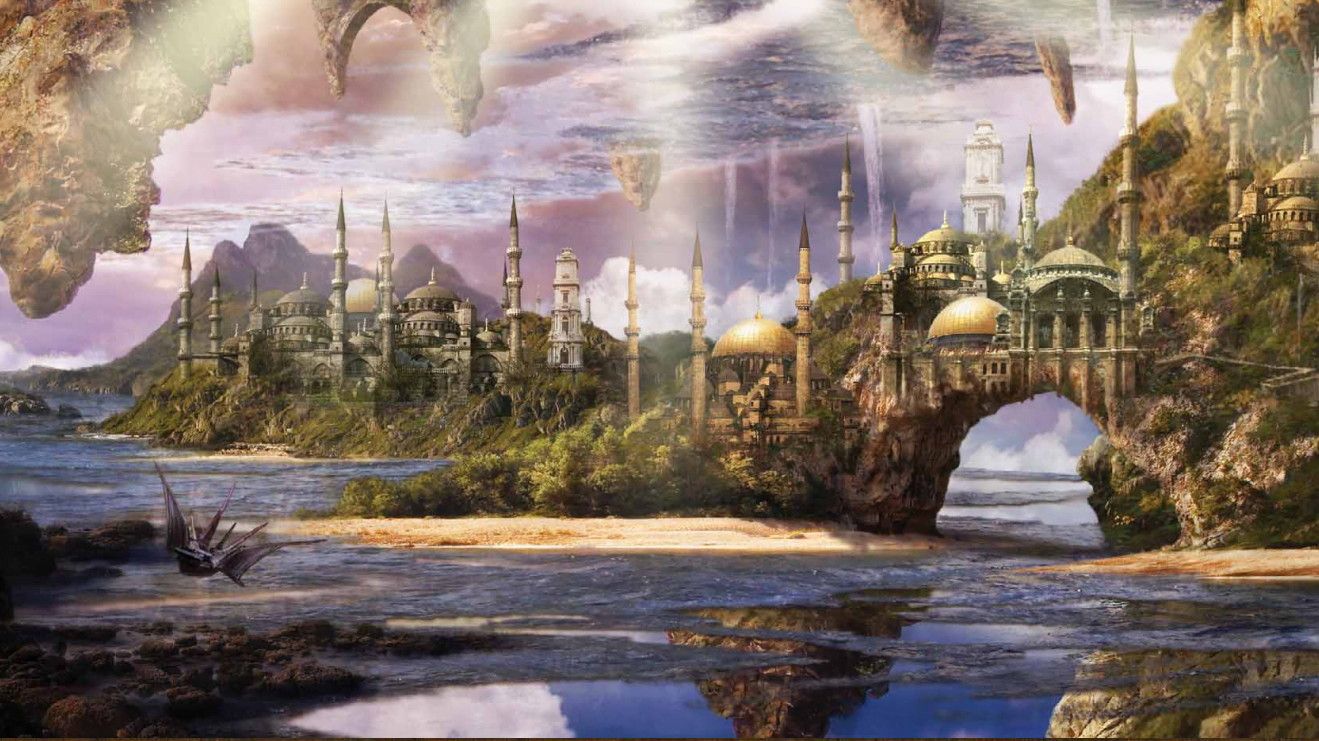Just because the overall conception of Fourth Edition’s cosmology is wonky and frustrating doesn’t mean that the actual locations within it can’t be excellent. Case in point: Hestavar, a paradisiacal city lying in the Astral Sea that’s set up as a possible hub world for epic level adventuring parties. Unlike so much else in this multiverse, it’s a strange world that doesn’t feel like anything on the Prime Material Plane, or anywhere else for that matter. It’s a realm of wonder with a structure impossible for any real city, and with that it’s also one of startlingly few new Fourth Edition locales that seem worth including in any planar campaign, which is about the highest praise I can give.
While it first appeared in the Manual of the Planes, “Hestavar: The Bright City” by Stephen Radney-MacFarland (Dragon #371, January 2009) greatly expands on the original material, which is important because Hestavar really needed the help. I described it earlier as “a boring enough location that I forgot about it entirely,” but that’s no longer the case. At all. This new write-up in no way contradicts what was there before, but it takes the simple concept of a city built up of earthbergs and spends time and energy considering what that actually means, i.e. that getting from one location to another is no simple matter. Much of the realm is disconnected, and as such requires ferries, flying, or leaps of faith in order for players to make their way around.
Radney-MacFarland doesn’t try to make the city into a conflicted battleground, either, which I really appreciated considering that nearly every other location in this edition is focused around combat. This is one of those points of light, but usually there’s an attempt at turning them into real spots of intrigue. Yes, there’s some politicking to be done here, but ultimately the rulers of this domain are always going to be the trio of gods who created it, and pissing them off means being answerable to tens of thousands of angels. Most noteworthy of all is the inclusion of temples to evil deities and even an ambassador from Hell who lives here. That doesn’t mean that the city is evil—it sure isn’t—just that it has a slightly more realistic attitude than a lot of fantasy cities, including most of them in Planescape. Ultimately, situating a location like this within that cosmology would be difficult, which is by no means a good thing about the Great Wheel.
Speaking of which, the realm from Planescape that Hestavar most reminded me of is Heliopolis, a triple-realm of goodness and law located in Arcadia. Both the best and worst things about that city were its focus on a real world mythology, as it both gave an interesting theme to the location and also limited its possibilities. Heliopolis never seemed like a great base, though, partially because it was never as well developed as Hestavar, but also due to the cosmology’s limitations. Hestavar isn’t Sigil, but it still has more shades of grey than anywhere outside of the Outlands in the old Outer Planes, and as such there’s some friction. The very fact that there are poorer and wealthier parts of the town and that this causes feuds feels both realistic and a bit refreshing. That this is partially a result of the city’s past really adds to its character, and makes Hestavar feel less like a game element and more alive.
My biggest demerit for this article is that for all the detail, there’s no map. Not one. And Hestavar could really use one, as it’s a complicated location, and getting around in it sounds like half of the fun. All of this is left for DMs, presumably for the same reasons that Fourth Edition usually eschews maps for locations. I really ached to see someone like Rob Lazzaretti try and capture the oddity of this location, and it came as no surprise that fans haven’t seemed to have made one either—the difficulty in conceptualizing this space is also what would make a map so invaluable.Aside from this fairly major flaw, there’s also a lot of references to a “Game of Making” that the locals are invested in, but this isn’t explained at any point; I’m hoping that we hear more about this in the later book focused solely on the Astral Sea.
Hestavar does seem difficult to transplant to the Great Wheel, but it also doesn’t seem completely out of sorts in Arcadia, the Outlands, or day I say it Bytopia. The biggest issue with this is the edition’s radically different conception of angels, petitioners, etc., which also makes it difficult to bring to any fantasy setting outside of Fourth Edition’s cosmology, even those that aren’t using Planescape’s. It’s also very much focused on epic-level characters and adventuring, and as a result the usefulfness of all of this material ends up limited—I don’t know how many people ever actually used it given the strictures involved. Nonetheless, I like Hestavar, or at least this article about it, and for once feel that it captures some of the fantastical nature of the planes, an element severely lacking in so much other planar material in this edition.




